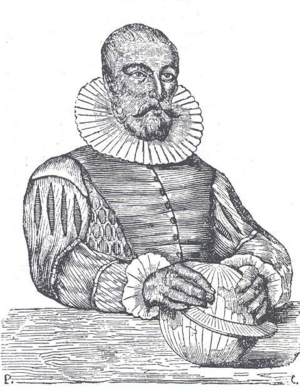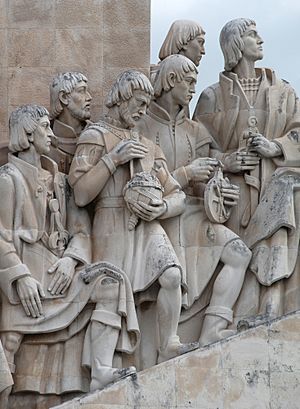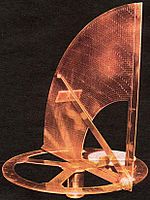Pedro Nunes facts for kids
Quick facts for kids
Pedro Nunes
|
|
|---|---|

Pedro Nunes, 1843 print
|
|
| Born | 1502 Alcácer do Sal, Portugal
|
| Died | 11 August 1578 (aged 76) |
| Nationality | Portuguese |
| Occupation | Mathematician, cosmographer, and professor |
| Signature | |
 |
|
Pedro Nunes (Portuguese: [ˈpeðɾu ˈnunɨʃ]; Latin: Petrus Nonius; 1502 – 11 August 1578) was a famous Portuguese mathematician, cosmographer (someone who studies the universe), and professor. He is thought to have come from a family of New Christians, who were people of Jewish origin who had converted to Christianity.
Nunes is seen as one of the greatest mathematicians of his time. He is most famous for his work in nautical sciences, which include navigation and cartography (map-making). He was the first to use mathematics to understand these areas. He also came up with the idea of a loxodrome, which is a special type of curved path. He invented several tools for measuring, like the nonius, which was named after his Latin surname.
Contents
Life of Pedro Nunes
We don't know much about Pedro Nunes' early life or family. We know he was born in Alcácer do Sal, Portugal. His family might have been Jewish. Years later, his grandchildren faced problems with the Portuguese Inquisition. This was a time when people were questioned about their religious beliefs.
Pedro Nunes studied at the University of Salamanca and later at the University of Lisbon. He earned a degree in medicine in 1525. In the 1500s, doctors often used astrology (the study of how stars affect people). Because of this, Nunes also learned about astronomy and mathematics.
He continued studying medicine but also taught at the University of Lisbon. He taught subjects like Morals, Philosophy, Logic, and Metaphysics. In 1537, the university moved to Coimbra. Nunes moved there too and became a mathematics professor. He held this job until 1562.
This new math job was likely created to teach skills needed for navigation. This was very important for Portugal at the time. Controlling sea trade was the main way Portugal became wealthy. In 1544, mathematics became its own separate subject at the university.
Besides teaching, Nunes was also appointed Royal Cosmographer in 1529. He became Chief Royal Cosmographer in 1547 and held this important position until he died.
In 1531, King John III of Portugal asked Nunes to teach his younger brothers, Luís and Henry. Years later, Nunes also taught the king's grandson, who would become King Sebastian.
It's possible that Christopher Clavius, a future astronomer, attended Nunes' classes in Coimbra. Clavius was a key figure in the Gregorian Calendar and called Nunes a "supreme mathematical genius." Pedro Nunes passed away in Coimbra.
Pedro Nunes' Work
Pedro Nunes lived during a time when science was changing. Before, scientists mostly studied and commented on old writings. But during Nunes' time, people started to value experiments and new discoveries. Nunes was one of the last great scholars who focused on old texts. His first published work, "Tratado da Esfera," shows this. It had many comments and additions based on his deep knowledge of the universe. However, he also understood how important experiments were.
In his book Tratado da sphera, he believed that knowledge should be shared widely. So, he published his works in different languages. He wrote in Latin, which was the main language for scholars across Europe. He also wrote in Portuguese and Spanish (in his book Livro de Algebra).

Much of Pedro Nunes' work was about navigation. He was the first to understand something very important about ships. If a ship keeps a steady direction, it won't travel in a straight line (a great circle) across the Earth. Instead, it will follow a special spiral path called a loxodrome. These lines are also called rhumb lines. They keep a fixed angle with the meridians (lines of longitude).
In his book Treaty defending the sea chart, Nunes said that nautical charts should show parallels (lines of latitude) and meridians as straight lines. But he wasn't sure how to solve the problems this caused on maps. This problem was finally solved when Mercator created the Mercator Projection. This map system is still used today.
Geometry Problems
Nunes also solved a complex problem in geometry. He figured out how to find the day with the shortest amount of twilight (the time after sunset or before sunrise). He also found out how long that twilight would last. This problem might not seem very important, but it showed how brilliant Nunes was at geometry. Other famous mathematicians, Johann and Jakob Bernoulli, tried to solve it over a century later. They found the shortest day but couldn't figure out its duration. This was because they struggled with differential calculus, a new math tool at the time. Nunes' achievement showed he was a pioneer in solving problems about maximum and minimum values, which became common later with calculus.
Understanding the Universe
Pedro Nunes was probably the last major mathematician to make important improvements to the ptolemaic system. This was an old idea that said the Earth was the center of the universe. Over time, this idea was replaced by the heliocentric system, which said the Sun was the center. This idea was proposed by Nicolaus Copernicus. Nunes knew about Copernicus's work. He mentioned it briefly in his books, mostly to correct some math errors.
Many of Nunes' achievements were possible because he deeply understood spherical trigonometry. This is a type of geometry used for calculations on the surface of a sphere, like the Earth. He was also good at using Euclidean geometry (standard flat-surface geometry) in new ways.
Amazing Inventions
Nunes worked on many practical problems for sailors. He tried to find ways to correct a ship's course. He also wanted to create better tools to find a ship's exact location at sea.
He invented the nonius to make instruments like the quadrant (instrument) more accurate. The nonius had several concentric circles (circles inside each other). Each circle had slightly fewer divisions than the one outside it. For example, the outermost circle might have 90 divisions for 90 degrees. The next inner circle would have 89 divisions, and so on. When an angle was measured, you would note where the pointer fell on the circles. Then, you would look up the exact measurement in a table.
The nonius was used by Tycho Brahe, a famous astronomer, but he found it too complex. Other scientists like Christopher Clavius and Jacob Curtius improved on Nunes' method. Later, in 1631, Pierre Vernier made even better improvements. This led to the Vernier scale, which has two scales, one fixed and one movable. Vernier himself said his invention was an improved nonius. For a long time, it was still called the "nonius," even in France. In some languages, like Swedish (nonieskala), the Vernier scale is still named after Nunes.
Pedro Nunes also studied some mechanics problems, looking at them from a mathematical point of view.
Influence of Pedro Nunes
Nunes had a big impact on scientists in other countries. For example, his work influenced John Dee and Edward Wright.
Honours and Legacy
- One of the most well-known public high schools in Lisbon is named after Pedro Nunes. It's called Escola Secundária de Pedro Nunes. It was founded in 1906. Many famous Portuguese people have studied there.
- He was featured on 100 escudos coins, which were Portugal's currency before the Euro.
- The Instituto Pedro Nunes in Coimbra is named after him. It's a center for new businesses and technology, started by the University of Coimbra.
- Asteroid 5313 Nunes is named after him.
- TAP Portugal Airlines named an Airbus A330-202 airplane after him.
See also
 In Spanish: Pedro Nunes para niños
In Spanish: Pedro Nunes para niños


